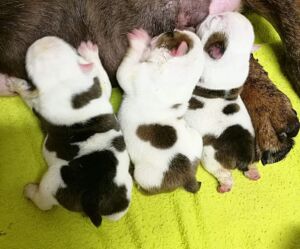MONORCHIDISM AND CRYPTORCHIDISM
The term cryptorchidism indicates the absence of one or both testicles due to failure to descend into the scrotal lodge, these are still present elsewhere. On the contrary, the pathology indicated by the term monorchidism indicates the absolute absence of a testicle. The testicles are equal organs positioned in the scrotum, responsible for the synthesis of sex hormones such as androgens and estrogens; their function is controlled by the gonadotropins LH and FSH, in turn produced by the pituitary gland. Both testicles must be in the scrotum at eight weeks of age, but it is not possible to make a definitive diagnosis before the puppy is six months old. The absence of one or both testicles in their location, as early as the tenth day or a little after the birth of the puppy, is defined as cryptorchidism. The hereditary transmission of cryptorchidism has been suspected for some time, deriving from the observation that the defect occurs more frequently in certain breeds than in others. Furthermore, its incidence increases in some breeding lines with a particularly high percentage of inbreeding. The hereditary mechanism is traced to a single sex-linked autosomal recessive gene, however this theory would not explain, for example, how the defect can occur alternately for the right or left testicle, so heredity would seem to involve at least two genes. The father of the cryptorchid subject is certainly a carrier of the defect, the mother and relatives in direct line are potential carriers. The elimination from reproduction of the subject affected by the disease does not guarantee to eliminate the defect in the progeny: however, if it were possible to eliminate all relatives from reproduction, obviously the incidence of the problem should be reduced. Cryptorchidism is quite common in dogs and has been found in at least 68 breeds; the average incidence is about 10%, higher in purebred subjects, higher with a percentage of 2.7% in small dogs compared to large ones. The diagnosis is simple: through palpation, the absence of one or both testicles is observed. From the anatomical point of view it is important to remember that the descent into the scrotum of a testicle is divided into three phases: intra-abdominal, intra-inguinal and extra-inguinal. The presence of the testicle in the abdomen cannot obviously be diagnosed by palpation, sometimes it is diagnosed by ultrasound; the simple palpation can instead highlight the presence of the testicle under the skin. At about two months of age, if one or both testicles are missing from the palapation, a drug therapy based on gonadotropins can be started which in some cases produces good results. In the event of a negative result, the surgical repositioning of the repressed testicle can be evaluated. The results are better if the surgery is carried out within four months of age. However, it is wise to remove the undescended testicle, as its permanence in the abdomen can increase the possibility of contracting a tumor. Cryptorchidism, whether monolteral or bilateral, is present in almost all blood lines, even if it is a recessive trait and is very difficult to eradicate from breeding, especially in professional structures that use stallions outside their own line. The breeder's correctness lies in not giving up the puppy until both testicles have descended, or warns of the lack of one or both, this in consideration of the fact that the definitive diagnosis of cryptorchidism can only be made at six months of age. 'age. The fact remains certain that if the testicles do not go down, the cost of the puppy must undergo a change. Various therapies are available to us in an attempt to bring the testicle back into place, such as surgical repositioning of the testicle by anchoring or hormonal drug treatments.
Read more by clicking on the images or categories
- All
- Dermatology
- Eye Pathologies
- Prophylaxis and Vaccines
- Bulldog Breathing
- Reproduction
- Various

LAMENESS

OTITIS

HIP DYSPLASIA

INGROWN TAIL

SWIMMING PUPPY SYNDROME

CHONDROPROTECTED

OTOHEMATOMA

PYOMETRA

MONORCHIDISM AND CRYPTORCHIDISM

HYSTERIC PREGNANCY

HEAT AND FALSE HEAT

PROLAPSE OF THE URETHRA

DISTICHIASI

ENTROPION

HYPERTROPHY OF THE GLAND OF THE THIRD PALPEBRA (CHERRY EYE)

HEAT STROKE

WHY DOES THE BULLDOG BREATHE BAD?

LEPTOSPIROSIS

VACCINAL PROPHYLAXIS

LEISHMANIOSIS

PHILARIOSIS

ATOPIC ALLERGY

PIODERMITE

INTERDIGITAL CYSTS

PODODERMATITIS

ACNE

CYCLIC ALOPECIA OF THE FLANK

DEMODECTIC MANGE
